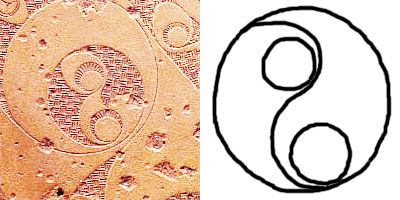
This page created 23 March 2014, and last modified: 25 September 2015 (missing Maier reference numbers added)

The 12th of the 18 pseudocomitatenses units listed (98/9.142 in Ingo Maier's numbering scheme) in the Magister Peditum's infantry roster is called the Mauri osismiaci;it is assigned (102/5.146) to the Magister Equitum's Gallic command. Its shield pattern (97#14) as shown in various manuscripts, under the matching label (97.o) Mauri osismiacii, is as below:

The shield pattern features an indigo rim (red in W, faded to pink in M) with a main field divided into two with a swirling taijitu or "yin-yang" pattern in yellow and green (faded to yellow in M; in W, a portion of each lobe is white); each of the two lobes has incised lines, including a central disc (which is coloured white in W). Despite the shield pattern's resemblance to the well-known Chinese Taoist pattern, it should be noted that the yin-yang / taijitu pattern is not known from Chinese sources until something like 500 years after the date of the composition of the original Notitia (see also the Armigeri defensores seniores (98/9.101), also in the Gallic field army, and which carries a similar shield pattern).
Closer to the Notitia than Song China in terms of both geographical origin and time, are Celtic motifs. Below left is a detail from the Desborough mirror, a bronze mirror dated to 50 BC - 50 AD found in 1908 in Northamptonshire, England.

Swirling S-curves such as featured in the Desborough mirror are a common feature in early Celtic art (especially in the British isles); often three such whorls will come together to form a triskeles. Such a Celtic motif would be particularly appropriate pattern for a unit serving in the Gallic field army.
It would appear that this unit is the same as the men (formerly) commanded by the Praefectus militum Maurorum Osismiacorum (151.5) at Osismis (modern Brest) under the Dux tractus Armoricani et Nervicani; see under his entry for details. The name Mauri denotes the Moorish peoples, although there is every indication that by this date the term, as used in the Roman military, denoted not an ethnicity but a particular kind of military unit, although exactly what is hard to say (probably a light unit; whether of horse or, as in this case, of foot), as it is also very likely that this meaning had also been superseded with time (most Roman infantry units likely now having their own integral light troops), leaving the name doubly fossilized! Assuming the identification of the Gallic and the Armorican Osismiaci units is correct, this implies the unit was a legionary, rather than auxiliary, unit of pseudocomitatenses, since it was commanded by a prefect rather than a tribune.

Return to the Notitia alphabetical unit list page.
Return to my Notitia index page.